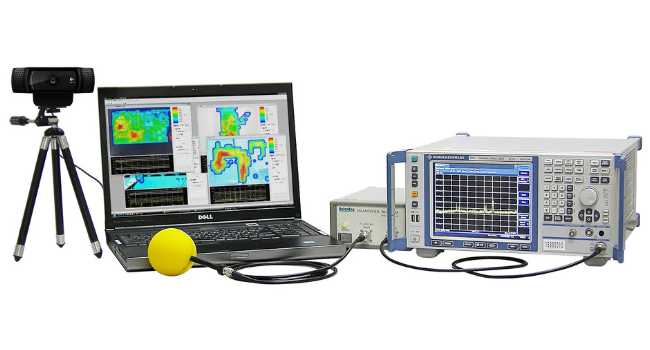The Rigol EMI Test System Software is designed to make precompliance scanning with a Rigol DSA family of Spectrum Analyzer easy.
This Note is an addendum to the Software User’s Guide. We will set up a prescan, create an amplitude correction table, set limit lines, and perform a final scan.
Initial Setup:
– Download the latest version of UltraSigma and the EMI Test System Software from the Rigol website.
– Connect your instrument (USB, LAN, or other) and set up the physical test environment (cabling, Device-Under-Test, etc..)
– Start UltraSigma
– USB connected instruments should appear in the UltraSigma Resource tree as shown below:
– Right-click on the resource and select EMI Test System
– The EMI Test System will perform a screen grab of the Spectrum Analyzer and open:
Configure Prescan Parameters
– Press Edit Scan to open the scan parameters window
– A Pre Scan consists of subrange elements. You can use the Pre Scan Configure window to set the overall Scan Start, Scan Stop, Range, and Detector type to use throughout the test:
Pre Scan Configuration sets the overall test parameters used in each subrange scan. Using a Positive Peak detector will allow you to perform a faster scan and identify problem areas:
In this example, we have configured the first subrange to sweep from 9kHz to 10MHz at an RBW of 1MHz, no attenuation, and no preamplifier.
– Subrange Configuration sets the parameters used for each subrange step:
In this example, we add a second step that goes from 10MHz to 30MHz in at an RBW of 300kHz:
Build successive subrange configurations using Range Start and Range Stop values and use the Add, Insert Before, After, and Delete to arrange the scan
– Press OK after you have built the Pre Scan list:
– Press Prescan to collect prescan data:
After the scan is complete, you should have a graphical display of each subrange stitched together onto one graph:
– Now you can add amplitude correction by pressing Ampt Corr:
– You can select Antenna, Cable, Other, or the User tab to specify which correction table to edit.
– Enter the frequency point and corresponding correction level. Press Add to add the correction point to the table. Repeat until the full correction table is built.
– To apply a correction table, select the type (Antenna, Cable, Other, or User) from the check boxes and press Correction:
– You can save the correction files for later use by pressing the Save button.
You can add limit lines by pressing Peak Search to bring up the Peak Search window:
– You can add points to the limit line one-at-a-time by entering the frequency and level, then press add. Here, we have built a limit line comprise of four sections. You can also save the limit lines to recall them later by pressing Save:
– Use History to recall saved limit lines
– Press OK to apply the limit lines
– All of the peaks that have failed the limit test are shown at the bottom of the display:
– You can find specific peaks by clicking on the Peak number:
– You can also change the Vertical and Horizontal Scales by selecting the scales from the Y Unit and X Axis drop down boxes:
– You can print out a report of scanned data by pressing the Report button and filling in any information that you need.
– If you have found areas that fail the limit lines, you can save time by performing another prescan. This time, set the start and stop frequencies to encompass the failing peak(s).
– In this more focused scan, you may also want to use a Quasi Peak detector and FCC RBW settings (if your analyser is equipped with those options.

































































































 FREE SHIPPING £75+
FREE SHIPPING £75+
 CELEBRATING 50+ YEARS
CELEBRATING 50+ YEARS
 PRICE MATCH GUARANTEE
PRICE MATCH GUARANTEE




